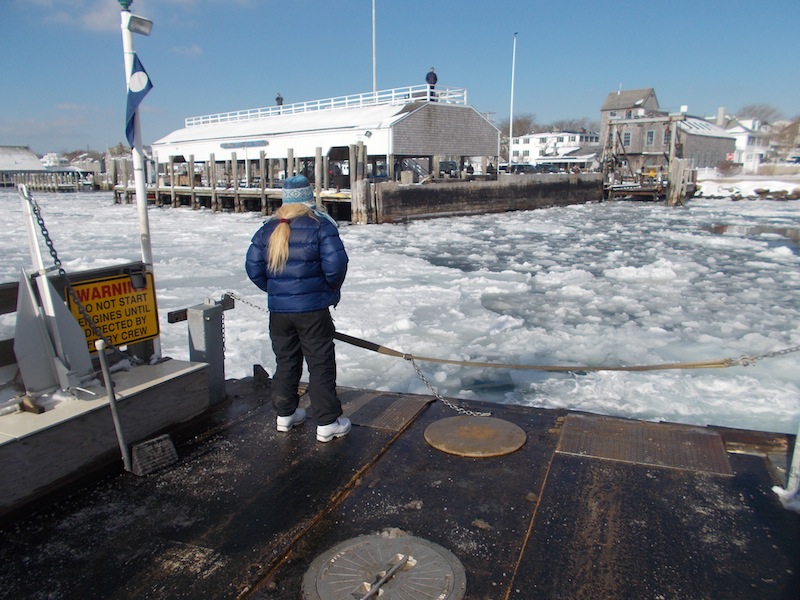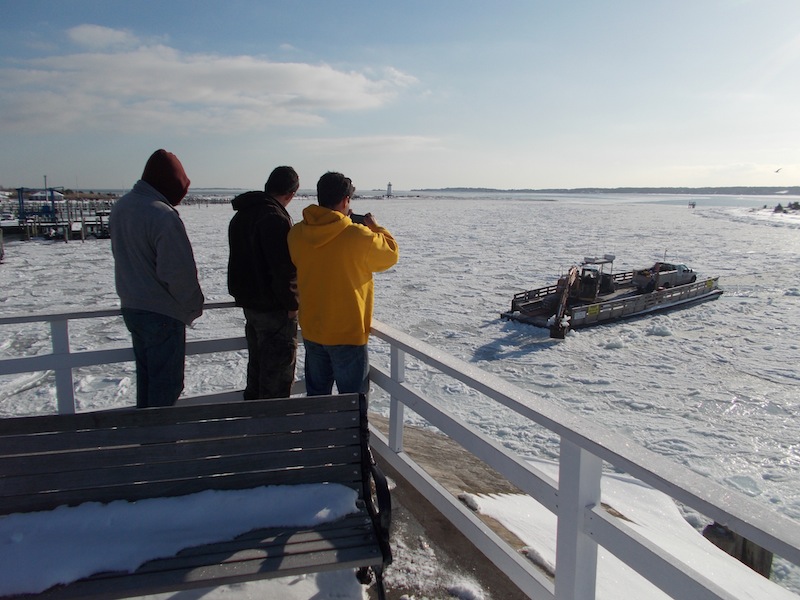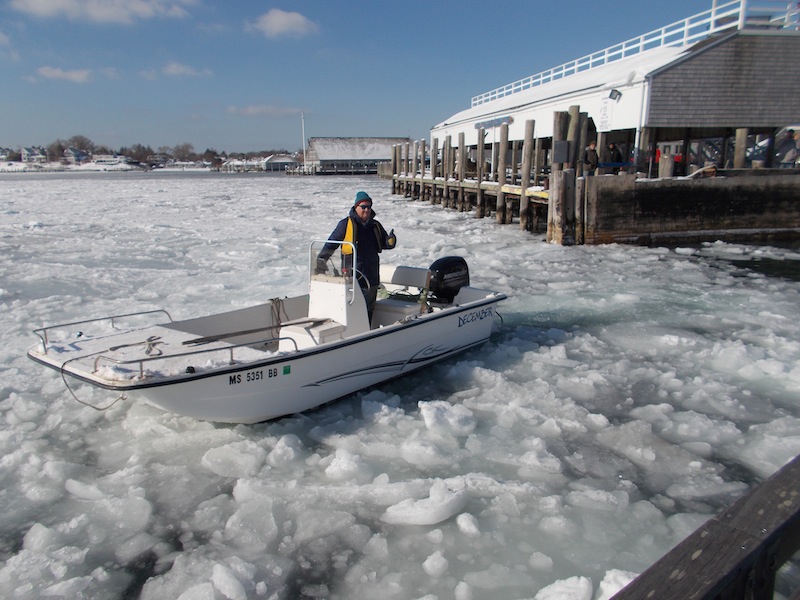In a fight won inch by inch and hour by hour, an excavator loaded heavily onto the bow of the On Time III dug a channel through a field of ice spanning the width of the entrance to Edgartown harbor Saturday morning, freeing the Chappy ferry to run for the first time since 8 p.m. Friday night.
The battle to open a passage across the harbor began shortly after 6:45 a.m. when Chappy ferry co-owner Peter Wells and maintenance manager Erik Gilley drove the company excavator down to the ferry slip at Chappy point.

They rolled the machinery far forward onto the deck of the On Time III and backed aboard the Chappy ferry utility truck to help balance the load. Even so, the ferry crept out of the Chappaquiddick slip lying low on the water and canted forward at an unnatural angle, the black rub rail around the bow shoveling into the expanse of ice at deck level and the stern raised high, even with the truck trying to weigh it down.
The goal was for Mr. Gilley to reach as far forward as possible with the bucket so that it could scoop ice out of path of the ferry. From the Edgartown side, Captains Robert Gilkes and Maddie LeCoq stood aboard the older ferry On Time II, its engine running hard so that wash from the propeller could open up some water in front of the boat.
In the harbor entrance lay a midland of ice, scalloped together in plates with edges raised by the compressive forces of the incoming tide. As the captains squinted into the sunrise, the ferry and excavator approached from the other side. The ice glared white and faintly blue. The temperature was four degrees, but the wind was still and the sun felt strangely mild on the face.
Captain LeCoq looked around and shook her head. “We’re just getting used to these temperatures. Because these are not normal. Not for the Vineyard,” she said.
To observers of the waterfront, the swift and unyielding advance of the ice into the harbor last night came as a surprise. It was true that ice had menaced the route of the ferry since Feb. 6, when temperatures of stinging cold and winds blowing hard from the northwest conjured a flattened world of whiteness to appear across the outer and inner harbors.

For nearly four weeks, the ice formed and moved quietly but with astonishing speed. At the end of a given day, the channel and much of the harbor near the town wharves would be a clear, deep, open-water blue. The next morning everything beyond the wharves or shorelines would look as crinkled and white as the Arctic Ocean. The ferry route across the harbor entrance might be as open as springtime in the late morning but a Pangaea of moving continents in the early afternoon.
The captains quickly learned to steer around the ice that moved in slow masses across their bows on the tide. They left behind roadways of open water that curved and twisted weirdly across the channel. They approached the slips slowly, especially on Chappy where bulkheads flank the slip on either side, allowing it to catch and trap ice in oatmeal-like piles. In the docks and on the trips across, it was not possible to run the ferries like icebreakers, pushing into the fields or rising to overtop them, then crushing everything with the weight of the boats and their loads.
“Basically what we don’t want is for the ice to dent the [forward] rudder or the propeller,” said Captain LeCoq, who was on duty yesterday afternoon. “So when I would come up to the edge of the ice, I would put it into reverse for a count of three at 1,500 r.p.m. or so, and then the reverse propulsion would push the ice out of the way, and I could creep forward a little bit more.”
Yesterday, outside the harbor, a long peninsula of ice stretched from Lighthouse Beach eastward to North Neck on Chappaquiddick. But though the temperature never broke 20 degrees, the early March day looked and felt almost spring like after the snowfall of the day before, which carpeted Chappy and the rest of the Vineyard with nearly a foot by sundown.
But Mr. Wells knew that if ice lay on either side of the 527-foot route over which his two ferries steam, the operation could not ignore it.

All yesterday afternoon, he drove the ferry workboat December back and forth along the edges of the ice, using the wake from the skiff to fracture the fields and encourage the great sheets to move in pieces with the tide rather than en mass. On duty from noon to 6 p.m., Captain LeCoq kept the On Time II nosing across the harbor with no difficulty at all.
“When Bob came in at six o’clock, it was completely clear,” said Captain LeCoq . “But then when the tide changes, it all comes back in.”
And so it did from the outer harbor when the tide turned and the current began to run into the entrance a little after 7 p.m. yesterday. The invasion of ice began about half an hour later, suddenly and overwhelmingly. It quickly filled the channel and – contrary to previous onslaughts, which mostly affected the Chappy side – piled up against the long bulkhead of the Edgartown slip.
“From the first trails coming by until [it turned difficult], it couldn’t have been any more than 15 minutes,” Captain Gilkes said. “On the third trip, I started having trouble, and the fourth trip I got to the end of [a neighboring pier], and from there to the ramp took me 10 minutes.”
The ice was viscous, measuring up to a foot thick when banked up against a bulkhead or along the shoreline. Captain Gilkes finessed his way into the Edgartown dock, but after unloading her freight of cars at 8:25 p.m., he and the On Time II found themselves embedded in the slip. In the off-season, the ferry stops running at 11:15 p.m.

“Eleven o’clock last night, I had seven or eight cars lined up here,” he said. From the Chappy side, Mr. Wells tried to cut a passage across the harbor in the workboat but couldn’t make it. “He got about halfway across in slushy stuff, and then called it. He said, ‘No, we’re not going to run.’ I guess he was worried that it was still moving and it was going to close up and the ferry would get caught out there. It was the first time I haven’t been able to do my rounds in 18 years.”
On both sides, Mr. Wells and Mr. Gilkes explained to motorists waiting for the last ferry home that the boats, for the first time in perhaps a generation, were stuck where they were. Mr. Wells, who also serves as captain of the Chappaquiddick fire station and an EMT, then called officials in town to try to devise a plan to move someone off Chappaquiddick if he or she needed emergency help.
“We’d spoken to Oak Bluffs about bringing their boat over,” assistant fire chief Andrew Kelly said this morning while watching the On Time III and excavator try to pioneer their way across the harbor. “There were concerns. We were working on it – but this is the first time in how long?” The department was prepared to call Boston MedFlight to fly someone off Chappy if that had been necessary, he added.
After two hours Mr. Gilley, Mr. Wells, the excavator and the On Time III were nearing the Edgartown slip. At Memorial Wharf, 10 bystanders watched how the rescuing ferry and excavator were handling the task of digging away the ice and then nosing forward. With its bow pushed down to the level of the harbor ice and the stern rising sharply above, the On Time III looked as though it had taken on tons of water and was struggling to stay afloat.
Mr. Gilley sometimes swung the bucket back and forth in a sawing motion through the ice in front of the bow of the ferry. When he did, the On Time III listed pointedly in that direction. When the bucket scooped up a great ragged foundation of ice, the bow dug down farther until Mr. Gilley swung the load to the side and dumped it back into the water. (“It got a little tippy back there,” he said later.)
Its engine growling, the On Time III crept forward another two to three inches every time the excavator reached out and yanked another mass of ice out of its way. Aboard the slip-bound On Time II, Captain Gilkes used a boathook to push a few last bergs to one side. When he and Mr. Wells judged that the ice between the two boats was light and mushy enough to push through, Captain LeCoq raised the ramp, Captain Gilkes eased the throttle forward, and for the first time in 12 hours, the two Chappaquiddick ferries, one after the other, set out for the other side.






Comments (7)
Comments
Comment policy »